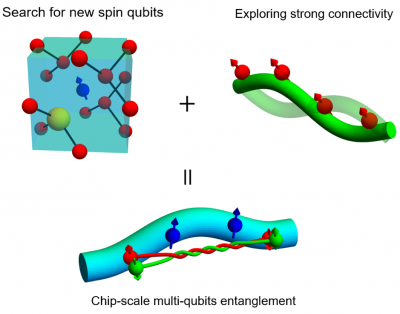Main Page
- We are organizing the International Workshop on Solid-State Qubits to be held on April 22-24, 2019.
The Solid-State Qubits Lab explores defect-based qubits in solids that are able to perform multi-qubit operations to develop new quantum applications with the potential to dramatically improve technology for communication, computing, and sensing. In order to achieve the goal, the lab explores new host materials, nano-mechanics based hybrid systems, quantum control of spin qubits using microwave cavities, and generation of multipartite entanglement over macroscopic length scales.

Quantum information science has been generating an ever-growing interest from the scientific communities and is now making their way toward industrial realization. Many of the world’s major technology firms are taking on the challenge of creating ‘universal’ quantum computers based on solid-state qubits. With the help of relatively mature superconducting hardware technologies, for instance, IBM recently launched a 50-quantum-bit (50-qubit) quantum computer, while Google demonstrated quantum simulations of complicated quantum chemistry problems. However, there remain various challenges in realizing practical quantum computers and searches for the optimal quantum platform are still in the race.
Quantum spin defects known as color centers in solids are promising candidates as they exhibit both long qubit coherence and fast qubit control. Furthermore, they can be fabricated as chipset devices and have the great potential of scalability. Strong coupling between spin qubits may be possible, employing the interface between spins and nanomechanical vibrational modes or microwave cavity modes in superconducting circuits. The Solid-State Qubits Lab seeks to focus on the critical issues of creating new spin defects and controlling the interaction between disparate spin qubits. The Lab builds on our collective expertise in studying quantum information, quantum control, and materials physics.
The central aim of The Solid-State Qubits Lab is to develop a quantum network based on a few entangled qubits. To achieve this goal, we have divided our efforts into three main focus area. In Focus area 1, we search for new defect-based qubits in diverse host solid-state materials. To efficiently perform this task, we use a material design approach, in which a theoretical prediction on promising defect candidates is first made, followed by experimental verifications including materials growth and characterizations. In Focus area 2, we concentrate on the coupling mechanism and connectivity of a few qubits. We particularly consider strong coupling schemes relying on nano-mechanical vibrational modes and microwave cavity modes, which are suitable to realize quantum network and quantum simulations. In Focus area 3, we develop chipset devices based on the new defects and host materials studied in Focus 1 and demonstrate multi-qubits entanglement based on the coupling mechanism explored in Focus 2. We study amplification and decay of generated entanglement in a quantum node of few qubits and examine long-range interaction between the quantum nodes using mechanical modes or microwave cavity modes.